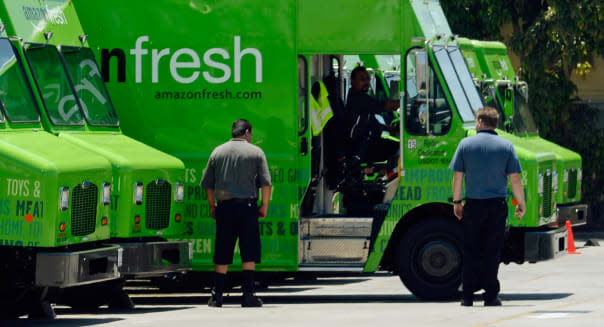Will You Pay Amazon $299 a Year for Grocery Delivery?

Having fresh groceries delivered to your door by Amazon.com (AMZN) is going to cost you a bit more now. The leading online retailer announced that most customers receiving AmazonFresh deliveries will have to pay $299 a year for a new PrimeFresh plan.
We're not talking about folks placing an order for an 18-count box of Pringles or any of the other non-refrigerated edibles available through Amazon's traditional storefront and delivery methods. AmazonFresh is a platform that the dot-com darling originally launched in Seattle a few years ago, offering home delivery of refrigerated, frozen and dry groceries. The groceries are delivered in totes with insulated coolers and frozen gel packs. AmazonFresh has expanded into New York City, Philadelphia and major California markets. Deliveries have been free for orders of $50 or more, but that's now changing.
Amazon's been testing tiered pricing in California, but AmazonFresh customers in Seattle, New York City, and Philly are now being told that they will need to pay $299 a year to continue to receive groceries at home. That's a lot, but that also includes the traditional Amazon Prime subscription that costs $99 a year. In other words, AmazonFresh is effectively $200 a year for existing Prime shoppers. That's still high, but it's not so bad when you consider the time that you may be wasting at your local supermarket.
Checking Out
There is naturally some bellyaching from customers. No one likes to pay more for something. However, this is Amazon. It's the company that sells its own Kindle Fire-branded tablets for as little as $50, and even non-Prime customers can get free shipping on some orders. Amazon prides itself on keeping prices low, and passing those savings on to its customers. If Amazon is rolling out a new $299 annual cover charge, it's probably because it's the most cost-effective way to make the offering financially viable.
%VIRTUAL-WSSCourseInline-884%It's not easy to run a grocery delivery service. This isn't a new niche. The sudsy dot-com bubble days had traders buying in and out of Webvan, Peapod and traditional supermarket operators that dreamed of a fleet of refrigerated trucks and distribution centers. It didn't end nicely for many of the pioneers.
One can always argue that Amazon could just build the costs of doing business into the model. It can raise prices of the merchandise. It can go with a high delivery price per order. The tiered pricing in California that it's testing does include both an annual subscription and a per-delivery charge without an annual subscription.
However, Amazon can also point to the success of its popular Amazon Prime program. It rolled that out a decade ago, and it has had no problem attracting tens of millions of customers -- even after bumping its annual subscription price from $79 to $99 last year. Just as Amazon Prime customers come to rely on the online giant for more of their merchandise needs after signing up, it's safe to assume that someone paying $299 for PrimeFresh will do more than just place a random order whenever a trip to the supermarket isn't convenient.
Amazon may as well test this price point now before it continues to expand AmazonFresh throughout the country. If Amazon Prime's success is any indication, there may be some initial resistance to paying in advance for a year of subsidized deliveries, but retention of those who do buy in should be pretty healthy.
Motley Fool contributor Rick Munarriz has no position in any stocks mentioned. The Motley Fool owns shares of and recommends Amazon.com. Try any of our Foolish newsletter services free for 30 days. Check out our free report on one great stock to buy for 2015 and beyond.

